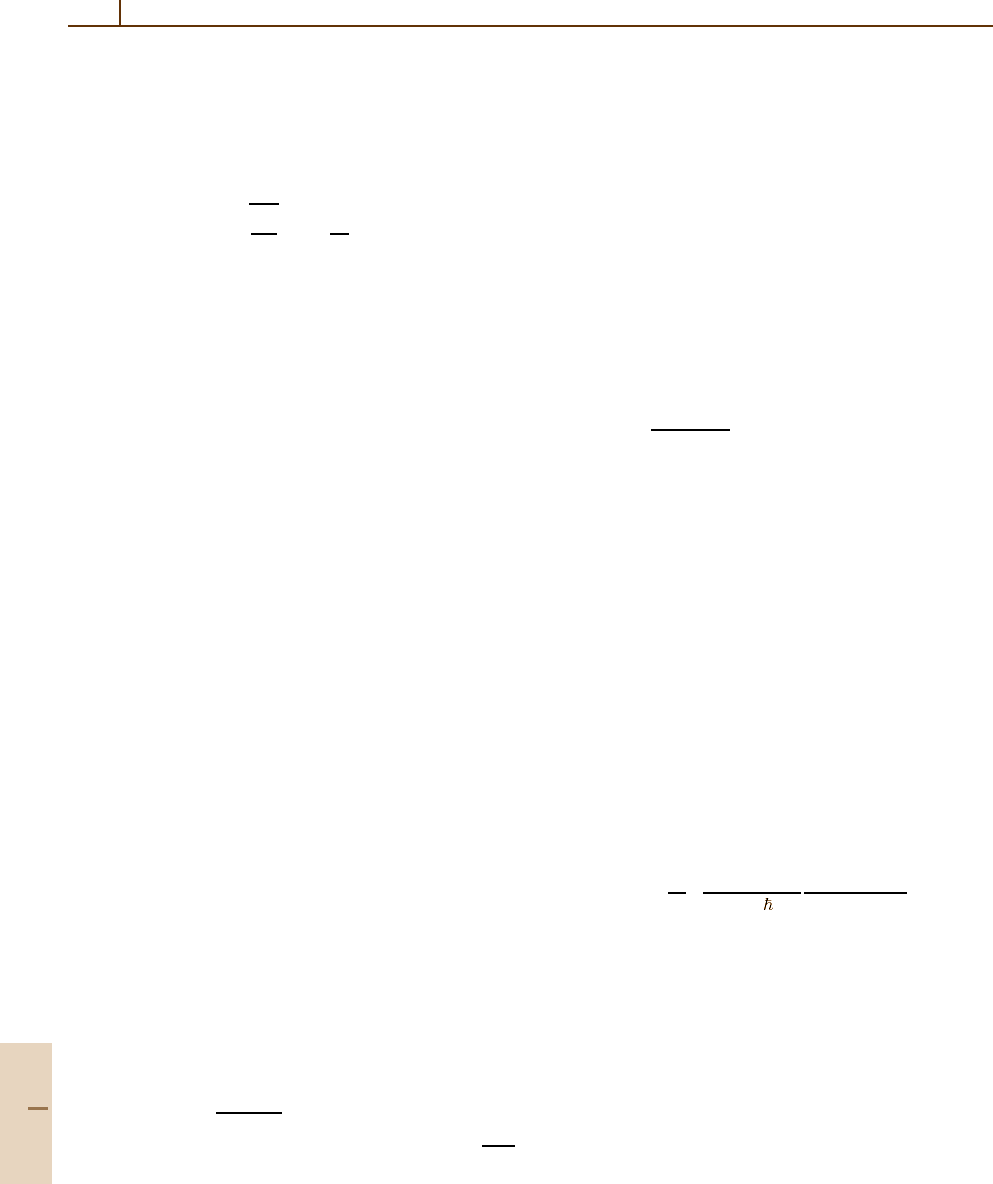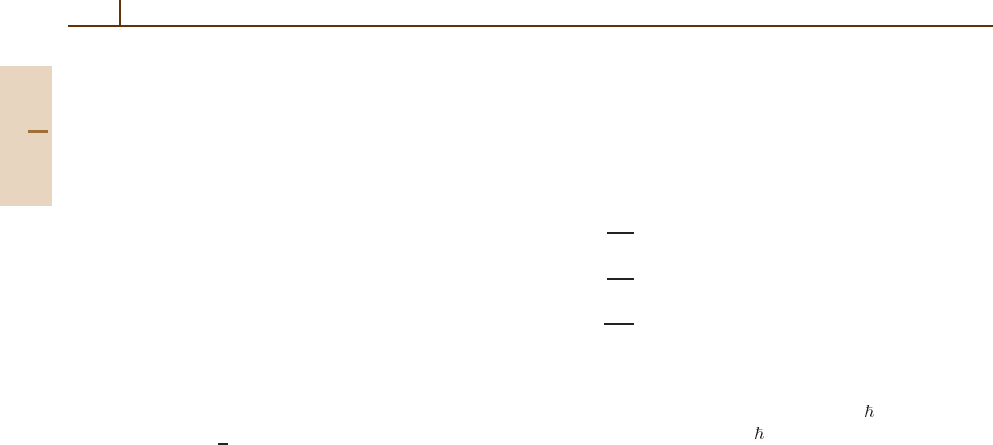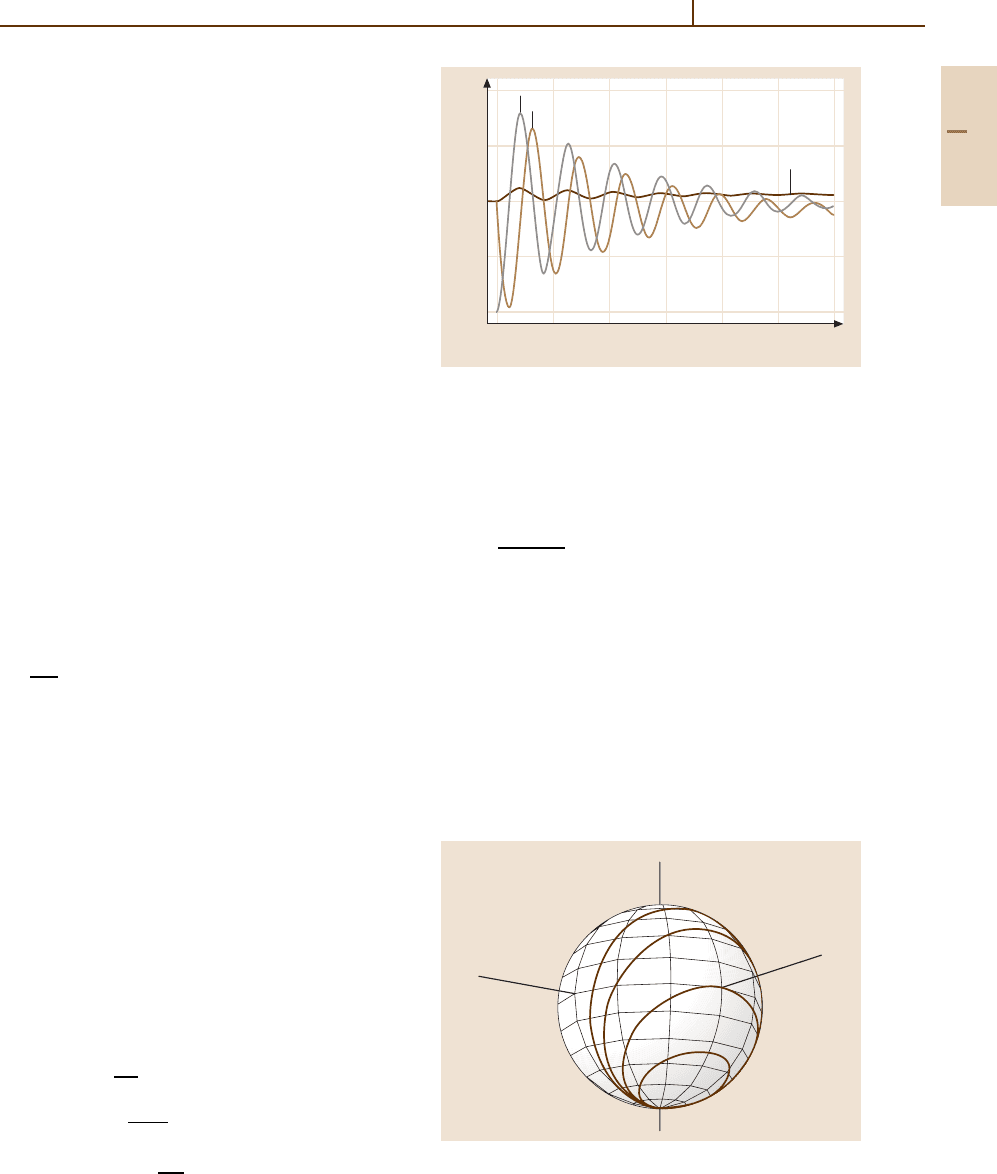Drake G.W.F. (editor) Handbook of Atomic, Molecular, and Optical Physics
Подождите немного. Документ загружается.


Nonlinear Optics 72.4 Third-Order Processes 1057
to a decrease in the effective length of the interac-
tion region. In particular, if w
0
is the radius of the
laser beam at the beam waist, the beam remains fo-
cused only over a distance of the order b =2πw
2
0
/λ
where λ is the laser wavelength measured in the non-
linear material. For many types of nonlinear optical
processes, the optimal nonlinear response occurs if
the degree of focusing is adjusted so that b is several
times smaller than the length L of the nonlinear optical
material.
72.4 Third-Order Processes
A wide variety of nonlinear optical processes are pos-
sible as a result of the nonlinear contributions to the
polarization that are third-order in the applied field.
These processes are described by χ
(3)
(ω
σ
;ω
m
,ω
n
,ω
o
)
(72.3) and can lead not only to the generation of new
field components (e.g., third-harmonic generation) but
can also result in a field affecting itself as it propa-
gates (e.g., self-phase modulation). Several examples
are described in this section.
72.4.1 Third-Harmonic Generation
Assuming full-permutation symmetry, the nonlinear
polarization amplitudes for the fundamental and third-
harmonic beams are
P
NL
(z,ω)=[ε
0
]3χ
(3)
eff
A(z,3ω)[A
∗
(z,ω)]
2
e
−i∆kz
,
P
NL
(z, 3ω) =[ε
0
]χ
(3)
eff
[A(z,ω)]
3
e
i∆kz
, (72.39)
where ∆k = 3k(ω) −k(3ω) and χ
(3)
eff
is the effective
third-order susceptibility for third-harmonic generation
and is defined in a manner analogous to the χ
(2)
eff
in (72.25). If the intensity of the fundamental wave is
not depleted by the nonlinear interaction, the solution
for the output intensity I(L, 3ω) of the third-harmonic
field for a crystal of length L is
I(L, 3ω) =
1
256π
4
ε
2
0
48π
2
ω
2
χ
(3)
eff
2
n(3ω)n(ω)
3
c
4
× I (ω)
3
L
2
sinh
2
[∆kL/2] , (72.40)
where I(ω) is the input intensity of the fundamental
field. As a result of the typically small value of χ
(3)
eff
in crystals, it is generally more efficient to generate
the third harmonic by using two χ
(2)
crystals in which
the first crystal produces second harmonic light and the
second crystal combines the second harmonic and the
fundamental beams via sum-frequency generation. It is
also possible to use resonant enhancement of |χ
(3)
|
in gases to increase the efficiency of third-harmonic
generation [72.8].
72.4.2 Self-Phase
and Cross-Phase Modulation
The nonlinear refractive index leads to an intensity-
dependent change in the phase of the beam as it
propagates through the material. If the medium is loss-
less, the amplitude of a single beam at frequency ω
propagating in the positive z-direction can be expressed
as
A(z,ω)= A(0,ω)e
iφ
NL
(z)
, (72.41)
where the nonlinear phase shift φ
NL
(z) is given by
φ
NL
(z) =
ω
c
n
2
Iz , (72.42)
and I =[4πε
0
]n
0
c|A(0,ω)|
2
/2π is the intensity of the
laser beam. If two fields at different frequencies ω
1
and
ω
2
are traveling along the z-axis, the two fields can affect
each other’s phase; this effect is known as cross-phase
modulation. The nonlinear phase shift φ
NL
1,2
(z) for each
of the waves is given by
φ
NL
1,2
(z) =
ω
1,2
c
n
2
(I
1,2
+2I
2,1
)z . (72.43)
For the case of a light pulse, the change in the phase
of the pulse inside the medium becomes a function of
time. In this case the solution to (72.33) for the time-
varying amplitude A(z,τ) shows that in the absence
of group-velocity dispersion (GVD) (i. e., β
2
= 0) that
the solution for A(z,τ) is of the form of (72.41), ex-
cept that the temporal intensity profile I(τ) replaces the
steady-state intensity I in (72.42). As the pulse propa-
gates through the medium, its frequency becomes time
dependent, and the instantaneous frequency shift from
the central frequency ω
0
is given by
δω(τ) =−
∂φ
NL
(τ)
∂τ
=−
ωn
2
z
c
∂I
∂t
.
(72.44)
This time-dependent self-phase modulation leads to
a broadening of the pulse spectrum and to a frequency
chirp across the pulse.
Part F 72.4

1058 Part F Quantum Optics
If the group velocity dispersion parameter β
2
and the
nonlinear refractive index coefficient n
2
are of opposite
sign, the nonlinear frequency chirp can be compensated
by the chirp due to group velocity dispersion, and (72.33)
admits soliton solutions . For example, the fundamental
soliton solution is
A(z, t) =
1
L
D
sech
τ
τ
p
e
iz/2L
D
, (72.45)
where τ
p
is the pulse duration and L
D
= τ
2
p
/|β
2
| is the
dispersion length. As a result of their ability to propagate
in dispersive media without changing shape, optical soli-
tons show a great deal of promise in applications such
as optical communications and optical switching. For
further discussion of optical solitons see [72.9].
72.4.3 Four-Wave Mixing
Various types of four-wave mixing processes can oc-
cur among different beams. One of the most common
geometries is backward four-wave mixing used in non-
linear spectroscopy and optical phase conjugation. In
this interaction, two strong counterpropagating pump
waves with amplitudes A
1
and A
2
and with equal fre-
quencies ω
1,2
=ω are injected into a nonlinear medium.
A weak wave, termed the probe wave, (with fre-
quency ω
3
and amplitude A
3
) is also incident on the
medium. As a result of the nonlinear interaction among
the three waves, a fourth wave with an amplitude A
4
is generated which is counterpropagating with respect
to the probe wave and with frequency ω
4
= 2ω −ω
3
.
For this case, the third-order nonlinear susceptibili-
ties for the probe and conjugate waves are given by
χ
(3)
(ω
3,4
;ω, ω, −ω
4,3
). For constant pump wave inten-
sities and full permutation symmetry, the amplitudes of
the nonlinear polarization for the probe and conjugate
waves are given by
P
NL
(z,ω
3,4
) =±[ε
0
]6χ
(3)
|A
1
|
2
+|A
2
|
2
A
3,4
+ A
1
A
2
A
∗
4,3
e
i∆kz
,
(72.46)
where ∆k = k
1
+k
2
−k
3
−k
4
is the phase mismatch,
which is nonvanishing when ω
3
=ω
4
. For the case of op-
tical phase conjugation by degenerate four-wave mixing
(i. e., ω
3
=ω
4
=ω and A
4
(L) = 0), the phase conjugate
reflectivity R
PC
is
R
PC
=
|A
4
(0)|
2
|A
3
(0)|
2
= tan
2
(κL), (72.47)
where κ =
1/16π
2
ε
0
24π
2
ωχ
(3)
/(n
0
c)
2
√
I
1
I
2
and
I
1,2
are the intensities of the pump waves. Phase-
conjugate reflectivities greater than unity can be
routinely achieved by performing four-wave mixing in
atomic vapors or photorefractive media.
72.4.4 Self-Focusing and Self-Trapping
Typically a laser beam has a transverse intensity profile
that is approximately Gaussian. In a medium with an
intensity-dependent refractive index, the index change
at the center of the beam is different from the index
change at the edges of the beam. The gradient in the
refractive index created by the beam can allow it to
self-focus for n
2
> 0. For this condition to be met, the
total input power of the beam must exceed the critical
power P
cr
for self-focusing which is given by
P
cr
=
π(0.61λ)
2
8n
0
n
2
, (72.48)
where λ is the vacuum wavelength of the beam. For
powers much greater than the critical power, the beam
can break up into various filaments, each with a power
approximately equal to the critical power. For a more
extensive discussion of self-focusing and self-trapping
see [72.10,11].
72.4.5 Saturable Absorption
When the frequency ω of an applied laser field is suffi-
ciently close to a resonance frequency ω
0
of the medium,
an appreciable fraction of the atomic population can
be placed in the excited state. This loss of population
from the ground state leads to an intensity-dependent
saturation of the absorption and the refractive index of
the medium (see Sect. 69.2 for more detailed discus-
sion) [72.4]. The third-order susceptibility as a result of
this saturation is given by
χ
(3)
=
1
ε
0
|µ|
2
T
1
T
2
α
0
c
3πω
0
2
δT
2
−i
1 +(δT
2
)
2
2
, (72.49)
where µ is the transition dipole moment, T
1
and T
2
are
the longitudinal and transverse relaxation times, respec-
tively (see Sect. 68.4.3), α
0
is the line-center weak-field
intensity absorption coefficient, and δ = ω −ω
0
is the
detuning. For the 3s ↔ 3p transition in atomic
sodium vapor at 300
◦
C, the nonlinear refractive index
n
2
≈ 10
−7
cm
2
/W for a detuning δT
2
= 300.
72.4.6 Two-Photon Absorption
When the frequency ω of a laser field is such that 2ω
is close to a transition frequency of the material, it is
Part F 72.4

Nonlinear Optics 72.5 Stimulated Light Scattering 1059
possible for two-photon absorption (TPA) to occur. This
process leads to a contribution to the imaginary part of
χ
(3)
(ω;ω, ω, −ω). In the presence of TPA, the intensity
I(z) of a single, linearly polarized beam as a function of
propagation distance is
I(z) =
I(0)
1 +βI(0)z
,
(72.50)
where β =
1/16π
2
ε
0
24π
2
ω Im
χ
(3)
/(n
0
c)
2
is the
TPA coefficient. For wide-gap semiconductors such as
ZnSe at 800 nm, β ≈ 10
−8
cm/W.
72.4.7 Nonlinear Ellipse Rotation
The polarization ellipse of an elliptically polarized laser
beam rotates but retains its ellipticity as the beam prop-
agates through an isotropic nonlinear medium. Ellipse
rotation occurs as a result of the difference in the
nonlinear index changes experienced by the left- and
right-circular components of the beam, and the angle θ
of rotation is
θ =
1
2
∆nωz/c
=
1
16π
2
ε
0
12π
2
n
2
0
c
χ
(3)
xyyx
× (ω;ω, ω, −ω)(I
+
−I
−
)z , (72.51)
where I
±
are the intensities of the circularly polarized
components of the beam with unit vectors
ˆ
σ
±
= (
ˆ
x ±
i
ˆ
y)/
√
2. Nonlinear ellipse rotation is a sensitive tech-
nique for determining the nonlinear susceptibility
element χ
(3)
xyyx
for isotropic media and can be used in
applications such as optical switching.
72.5 Stimulated Light Scattering
Stimulated light scattering occurs as a result of changes
in the optical properties of the material that are induced
by the optical field. The resulting nonlinear coupling be-
tween different field components is mediated by some
excitation (e.g., acoustic phonon) of the material that
results in changes in its optical properties. The nonlin-
earity can be described by a complex susceptibility and
a nonlinear polarization that is of third order in the inter-
acting fields. Various types of stimulated scattering can
occur. Discussed below are the two processes that are
most commonly observed.
72.5.1 Stimulated Raman Scattering
In stimulated Raman scattering (SRS), the light field
interacts with a vibrational mode of a molecule. The
coupling between the two optical waves can become
strong if the frequency difference between them is
close to the frequency ω
v
of the molecular vibrational
mode. If the pump field at ω
0
and another field com-
ponent at ω
1
are propagating in the same direction
along the z-axis, the steady-state nonlinear polariza-
tion amplitudes for the two field components are given
by
P
NL
(z,ω
0,1
) =[ε
0
]6χ
R
(ω
0,1
)
× |A(z,ω
1,0
)|
2
A(z,ω
0,1
), (72.52)
where χ
R
(ω
0,1
) ≡ χ
(3)
(ω
0,1
;ω
0,1
,ω
1,0
, −ω
1,0
),the
Raman susceptibility, actually depends only on the fre-
quency difference Ω = ω
0
−ω
1
and is given by
χ
R
(ω
0,1
) =
1
ε
0
N(∂α/∂q)
2
0
6µ
M
1
ω
2
v
−Ω
2
∓2iγΩ
,
(72.53)
where the minus (plus) sign is taken for the ω
0
(ω
1
)
susceptibility, µ
M
is the reduced nuclear mass, and
(∂α/∂q)
0
is a measure of the change of the polarizability
of the molecule with respect to a change in the inter-
molecular distance q at equilibrium. If the intensity of
the pump field is undepleted by the interaction with the
ω
1
field and is assumed to be constant, the solution for
the intensity of the ω
1
field at z = L is given by
I(L,ω
1
) = I(0,ω
1
)e
G
R
, (72.54)
where the SRS gain parameter G
R
is
G
R
=
1
16π
2
ε
0
48π
2
ω
1
(n
1
c)
2
Im[χ
R
(ω
1
)]I
0
L
= g
R
I
0
L , (72.55)
g
R
is the SRS gain factor, and I
0
is the input inten-
sity of the pump field. For ω
1
<ω
0
(ω
1
>ω
0
), the ω
1
field is termed the Stokes (anti-Stokes) field, and it ex-
periences exponential amplification (attenuation). For
sufficiently large gains (typically G
R
25), the Stokes
wave can be seeded by spontaneous Raman scatter-
ing and can grow to an appreciable fraction of the
pump field. For a complete discussion of the sponta-
Part F 72.5

1060 Part F Quantum Optics
neous initiation of SRS see [72.12]. For the case of CS
2
,
g
R
= 0.024 cm/MW.
Four-wave mixing processes that couple a Stokes
wave having ω
1
<ω
0
and an anti-Stokes wave
having ω
2
>ω
0
,whereω
1
+ω
2
= 2ω
0
, can also oc-
cur [72.4]. In this case, additional contributions to
the nonlinear polarization are present and are char-
acterized by a Raman susceptibility of the form
χ
(3)
(ω
1,2
;ω
0
,ω
0
, −ω
2,1
). The technique of coherent
anti-Stokes Raman spectroscopy is based on this four-
wave mixing process [72.13].
72.5.2 Stimulated Brillouin Scattering
In stimulated Brillouin scattering (SBS), the light field
induces and interacts with an acoustic wave inside the
medium. The resulting interaction can lead to extremely
high amplification for certain field components (i. e.,
Stokes wave). For many optical media, SBS is the
dominant nonlinear optical proccess for laser pulses of
duration > 1 ns. The primary applications for SBS are
self-pumped phase conjugation and pulse compression
of high-energy laser pulses.
If an incident light wave with wave vector k
0
and
frequency ω
0
is scattered from an acoustic wave with
wave vector q and frequency Ω, the wave vector and
frequency of the scattered wave are determined by con-
servation of momentum and energy to be k
1
=k
0
±q and
ω
1
=ω
0
±Ω, where the (+) sign applies if k
0
· q > 0and
the (−) applies if k
0
· q < 0. Here, Ω and q are related by
the dispersion relation Ω = v|q| where v is the velocity
of sound in the material. These Bragg scattering con-
ditions lead to the result that the Brillouin frequency
shift Ω
B
= ω
1
−ω
0
is zero for scattering in the for-
ward direction (i. e., in the k
0
direction) and reaches
its maximum for scattering in the backward direction
given by
Ω
B
= 2ω
0
vn
0
/c, (72.56)
where n
0
is the refractive index of the material.
The interaction between the incident wave and the
scattered wave in the Brillouin-active medium can be-
come nonlinear if the interference between the two
optical fields can coherently drive an acoustic wave,
either through electrostriction or through local dens-
ity fluctuations resulting from the absorption of light
and consequent temperature changes. The following
discussion treats the more common electrostriction
mechanism.
Typically, SBS occurs in the backward direction
(i. e., k
0
= k
0
ˆ
z and k
1
=−k
1
ˆ
z), since the spatial overlap
between the Stokes beam and the laser beam is maxi-
mized under these conditions and, as mentioned abov e,
no SBS occurs in the forward direction. The steady-
state nonlinear polarization amplitudes for backward
SBS are
P
NL
(z,ω
0,1
) =[ε
0
]6χ
B
(ω
0,1
)
× |A(z,ω
1,0
)|
2
A(z,ω
0,1
), (72.57)
where χ
B
(ω
0,1
) ≡ χ
(3)
(ω
0,1
;ω
0,1
,ω
1,0
, −ω
1,0
),the
Brillouin susceptibility, depends only on Ω = ω
0
−ω
1
and is given by
χ
B
(ω
0,1
) =
1
ε
0
ω
2
0
γ
2
e
24π
2
c
2
ρ
0
1
Ω
2
B
−Ω
2
∓iΓ
B
Ω
,
(72.58)
where the minus (plus) sign is taken for the ω
0
(ω
1
)
susceptibility, γ
e
is the electrostrictive constant, ρ
0
is
the mean density of the material, and Γ
B
is the Brillouin
linewidth given by the inverse of the phonon lifetime.
If the pump field is undepleted by the interaction with
the ω
1
field and is assumed to be constant, the solution
for the output intensity of the ω
1
field at z = 0isgiven
by
I(0,ω
1
) = I(L,ω
1
)e
G
B
, (72.59)
where the Brillouin gain coeffi cient G
B
is given by
G
B
=
1
16π
2
ε
0
48π
2
ω
1
(n
0
c)
2
Im[χ
B
(ω
1
)]I
0
L,
= g
0
ΩΩ
B
Γ
2
B
Ω
2
B
−Ω
2
2
+(ΩΓ
B
)
2
I
0
L
= g
B
I
0
L , (72.60)
g
B
is the SBS gain factor, I
0
is the input intensity of the
pump field, and
g
0
=
1
ε
2
0
ω
2
0
γ
2
e
n
0
c
3
ρ
0
vΓ
B
(72.61)
is the line-center (i. e., Ω =±Ω
B
) SBS gain factor.
For Ω > 0(Ω < 0), the ω
1
field is termed the Stokes
(anti-Stokes) field, and it experiences exponential am-
plification (attenuation). For sufficiently large gains
(typically G
B
25), the Stokes wave can be seeded
by spontaneous Brillouin scattering and can grow to
an appreciable fraction of the pump field. For a com-
plete discussion of the spontaneous initiation of SBS
see [72.14]. For CS
2
, g
0
= 0.15 cm/MW.
Part F 72.5

Nonlinear Optics 72.6 Other Nonlinear Optical Processes 1061
72.6 Other Nonlinear Optical Processes
72.6.1 High-Order Harmonic Generation
If full permutation symmetry applies and the fundamen-
tal field ω is not depleted by nonlinear interactions, then
the intensity of the qth harmonic is given by
I(z, qω) =
1
4π(4πε
0
)
(q−1)/2
×
2πq
2
ω
2
n
2
(qω)c
2πI(ω)
n(ω)c
q
×
χ
(q)
(qω;ω,... ,ω)J
q
(∆k, z
0
, z)
2
,
(72.62)
where ∆k =[n(ω) −n(qω)]ω/c,
J
q
(∆k, z
0
, z) =
z
z
0
e
i∆kz
dz
(1 +2iz
/b)
q−1
, (72.63)
z = z
0
at the input face of the nonlinear medium, and b is
the confocal parameter Sect. 72.3.5 of the fundamental
beam. Defining L = z−z
0
, the integral J
q
can be eas-
ily evaluated in the limits L b and L b. The limit
L b corresponds to the plane-wave limit in which
case
|J
q
(∆k, z
0
, z)|
2
= L
2
sinc
2
∆kL
2
.
(72.64)
The limit L b corresponds to the tight-focusing con-
figuration in which case
J
q
(∆k, z
0
, z) =
0, ∆k ≤0 ,
πb
(q−2)!
b∆k
2
q−2
e
−b∆k/2
,
∆k > 0 .
(72.65)
Note that in this limit, the qth harmonic light is
only generated for positive phase mismatch. Reintjes
et al. [72.15, 16] observed both the fifth and seventh
harmonics in helium gas which exhibited a depen-
dence on I(ω) which is consistent with the I
q
(ω)
dependence predicted by (72.62). However, more re-
cent experiments in gas jets have demonstrated the
generation of extremely high-order harmonics which
do not depend on the intensity in this simple manner
(see Chapt. 74 for further discussion of this nonpertur-
bative behavior).
72.6.2 Electro-Optic Effect
The electro-optic effect corresponds to the limit in which
the frequency of one of the applied fields approaches
zero. The linear electro-optic effect (or Pockels effect)
can be described by a second-order susceptibility of
the form χ
(2)
(ω;ω, 0). This effect produces a change
in the refractive index for light of certain polariza-
tions which depends linearly on the strength of the
applied low-frequency field. More generally, the linear
electro-optic effect induces a change in the amount of
birefringence present in an optical material. This elec-
trically controllable change in birefringence can be used
to construct amplitude modulators, frequency shifters,
optical shutters, and other optoelectronic devices. Ma-
terials commonly used in such devices include KDP and
lithium niobate [72.17]. If the laser beam is propagat-
ing along the optic axis (i. e., z-axis) of the material
of length L and the low-frequency field E
z
is also ap-
plied along the optic axis, the nonlinear index change
∆n = n
y
−n
x
between the components of the electric
field polarized along the principal axes of the crystal is
given by
∆n =
1
4π
n
3
0
r
63
E
z
(72.66)
where r
63
is one of the electro-optic coefficients.
The quadratic electro-optic effect produces a change
in refractive index that scales quadratically with the ap-
plied dc electric field. This effect can be described by
a third-order susceptibility of the form χ
(3)
(ω;ω, 0, 0).
72.6.3 Photorefractive Effect
The photorefractive effect leads to an optically induced
change in the refractive index of a material. In certain
ways this effect mimics that of the nonlinear refractive
index described in Sect. 72.1.2, but it differs from the
nonlinear refractive index in that the change in refrac-
tive index is independent of the overall intensity of the
incident light field, and depends only on the degree of
spatial modulation of the light field within the nonlinear
material. In addition, the photorefractive effect can oc-
cur only in materials that exhibit a linear electro-optic
effect, and contain an appreciable density of trapped
electrons and/or holes that can be liberated by the appli-
cation of a light field. Typical photorefractive materials
include lithium niobate, barium titanate, and strontium
barium niobate.
Part F 72.6

1062 Part F Quantum Optics
A typical photorefractive configuration might be
as follows: two beams interfere within a photorefrac-
tive crystal to produce a spatially modulated intensity
distribution. Bound charges are ionized with greater
probability at the maxima than at the minima of the dis-
tribution and, as a result of the diffusion process, carriers
tend to migrate away from regions of large light intensity.
The resulting modulation of the charge distribution leads
to the creation of a spatially modulated electric field that
produces a spatially modulated change in refractive in-
dex as a consequence of the linear electro-optic effect.
For a more extensive discussion see [72.18].
72.6.4 Ultrafast and Intense-Field
Nonlinear Optics
Additional nonlinear optical processes are enabled by
the use of ultrashort (< 1 ps) or ultra-intense laser pulses.
For reasons of basic laser physics, ultra-intense pulses
are necessarily of short duration, and thus these effects
normally occur together. Ultrashort laser pulses possess
a broad frequency spectrum, and therefore the disper-
sive properties of the optical medium play a key role in
the propagation of such pulses. The three-dimensional
nonlinear Schrödinger equation must be modified when
treating the propagation of these ultrashort pulses by
including contributions that can be ignored under other
circumstances [72.19,20]. These additional terms lead to
processes such as space-time coupling, self-steepening,
and shock wave formation [72.21, 22]. The process of
self-focusing is significantly modified under short-pulse
(pulse duration shorter than approximately 1 ps) exci-
tation. For example, temporal splitting of a pulse into
two components can occur; this pulse splitting lowers
the peak intensity, and can lead to the arrest of the usual
collapse of a pulse undergoing self-focusing [72.23].
Moreover, optical shock formation, the creation of a dis-
continuity in the intensity evolution of a propagating
pulse, leads to supercontinuum generation, the creation
of a light pulse with an extremely broad frequency
spectrum [72.24]. Shock effects and the generation of
supercontinuum light can also occur in one-dimensional
systems, such as a microstructure optical fiber. The rel-
atively high peak power of the ultrashort pulses from
a mode-locked laser oscillator and the tight confine-
ment of the optical field in the small (≈ 2 µm) core
of the fiber yield high intensities and strong self-phase
modulation, which results in a spectral bandwidth that
spans more than an octave of the central frequency
of the pulse [72.25]. Such a coherent octave-spanning
spectrum allows for the stabilization of the under-
lying frequency comb of the mode-locked oscillator,
and has led to a revolution in the field of frequency
metrology [72.26]. Multiphoton absorption [72.27] con-
stitutes an important loss process that becomes important
for intensities in excess of ≈ 10
13
W/cm
2
. In addi-
tion to introducing loss, the electrons released by this
process can produce additional nonlinear effects as-
sociated with their relativistic motion in the resulting
plasma [72.28, 29]. For very large laser intensities
(greater than approximately 10
16
W/cm
2
), the elec-
tric field strength of the laser pulse can exceed the
strength of the Coulomb field that binds the electron to
the atomic core, and nonperturbative effects can occur.
A dramatic example is that of high-harmonic genera-
tion [72.30–32]. Harmonic orders as large as the 341-st
have been observed, and simple conceptual models have
been developed to explain this effect [72.33]. Under
suitable conditions the harmonic orders can be suitably
phased so that attosecond pulses are generated [72.34].
References
72.1 N. Bloembergen: Nonlinear Optics (Benjamin, New
York 1964)
72.2 Y. R. Shen: Nonlinear Optics (Wiley, New York 1984)
72.3 P. N. Butcher, D. Cotter: The Elements of Non-
linear Optics (Cambridge Univ. Press, Cambridge
1990)
72.4 R. W. Boyd: Nonlinear Optics (Academic, Boston
1992)
72.5 J. A. Armstrong, N. Bloembergen, J. Ducuing,
P. S. Pershan: Phys. Rev. 127, 1918 (1962)
72.6 G. I. Stegeman: Contemporary Nonlinear Optics,ed.
by G. P. Agrawal, R. W. Boyd (Academic, Boston
1992) Chap. 1
72.7 See for example the Special Issue on: Optical Para-
metric Oscillation and Amplification, J. Opt. Soc.
Am. B 10 (1993) No. 11
72.8 R. B. Miles, S. E. Harris: IEEE J. Quant. Electron. 9,
470 (1973)
72.9 G. P. Agrawal: Nonlinear Fiber Optics (Academic,
Boston 1989)
72.10 S. A. Akhmanov, R. V. Khokhlov, A. P. Sukhorukov:
Laser Handbook, ed. by F. T. Arecchi, E. O. Schulz-
Dubois (North-Holland, Amsterdam 1972)
72.11 J. H. Marburger: Prog. Quant. Electr. 4, 35 (1975)
72.12 M. G. Raymer, I. A. Walmsley: Prog. Opt., Vol. 28,
ed. by E. Wolf (North-Holland, Amsterdam 1990)
Part F 72

Nonlinear Optics References 1063
72.13 M. D. Levenson, S. Kano: Introduction to Nonlinear
Spectroscopy (Academic, Boston 1988)
72.14 R. W. Boyd, K. Rzazewski, P. Narum: Phys. Rev. A
42, 5514 (1990)
72.15 J. Reintjes, C. Y. She, R. C. Eckardt, N. E. Karangelen,
R. C. Elton, R. A. Andrews: Phys. Rev. Lett. 37,1540
(1976)
72.16 J. Reintjes, C. Y. She, R. C. Eckardt, N. E. Karangelen,
R. C. Elton, R. A. Andrews: Appl. Phys. Lett. 30,480
(1977)
72.17 I. P. Kaminow: An Introduction to Electro-optic De-
vices (Academic, New York 1974)
72.18 P. Günter, J.-P. Huignard (Eds.): Photorefractive
Materials and Their Applications (Springer, Berlin,
Heidelberg, Part I (1988), Part II (1989))
72.19 T. Brabec, F. Krausz: Phys. Rev. Lett. 78, 3283 (1997)
72.20 J. K. Ranka, A. L. Gaeta: Opt. Lett. 23, 534 (1998)
72.21 J. E. Rothenberg: Opt. Lett. 17, 1340 (1992)
72.22 G. Yang, Y. R. Shen: Opt. Lett. 9,510(1984)
72.23 J. K. Ranka, R. Schirmer, A. L. Gaeta: Phys. Rev. Lett.
77, 3783 (1996)
72.24 A. L. Gaeta: Phys. Rev. Lett. 84, 3582 (2000)
72.25 J. K. Ranka, R. S. Windeler, A. J. Stentz: Opt. Lett.
25, 25 (2000)
72.26 D. J. Jones, S. A. Diddams, J. K. Ranka, A. Stentz,
R. S. Windeler, J. L. Hall, S. T. Cundiff: Science 288,
635 (2000)
72.27 W. Kaiser, C. G. B. Garrett: Phys. Rev. Lett. 7, 229
(1961)
72.28 P. Sprangle, C.-M. Tang, E. Esarez: IEEE Transactions
on Plasma Science 15,145(1987)
72.29 R. Wagner, S.-Y. Chen, A. Maksemchak, D. Um-
stadter: Phys. Rev. Lett. 78, 3125 (1997)
72.30 P. Agostini, F. Fabre, G. Mainfray, G. Petite,
N. K. Rahman: Phys. Rev. Lett. 42, 1127 (1979)
72.31 Z. Chang: Phys. Rev. Lett. 79, 2967 (1997)
72.32 Z. Chang: Phys. Rev. Lett. 82, 2006 (1999)
72.33 P. B. Corkum: Phys. Rev. Lett. 71, 1994 (1993)
72.34 H. R. Kienberger, Ch. Spielmann, G. A. Reider,
N. Milosevic, T. Brabec, P. Corkum, U. Heinz-
mann, M. Drescher, F. Krausz: Nature 414,509
(2001)
Part F 72

1065
Coherent Tran
73. Coherent Transients
Coherent optical transients are excited in atomic
and molecular systems when a stable phase
relation persists between an exciting light
field and the system’s electronic response. The
extreme sensitivity of phase-dependent effects is
responsible for the many applications of optical
transient techniques in atomic and molecular
physics [73.1–7].
The theory of coherent transients distinguishes
carefully between two types of relaxation: homo-
geneous and inhomogeneous. Relaxation occurs
whenever the environment of a physical system
fluctuates randomly. By random environment one
means the combination of all interactions that are
too complex to be treated fundamentally, and that
can be seen to lead to degradation of the degree of
coherence of a particular interaction of main inter-
est. The time scale of environmental fluctuations
then provides the division between the two types.
When environmental fluctuations are suf-
ficiently rapid that all dynamical systems in a
macroscopic sample experience the whole range
of fluctuations in a time short compared with the
time of an experiment, the resultant relaxation
is called homogeneous. If environmental fluctu-
ations exist randomly over a macroscopic sample,
but change relatively slowly in time, then the re-
laxation is called inhomogeneous. For example,
weak distant collisions are experienced constantly
by all atoms at thermal equilibrium in a vapor
cell, and give rise to homogeneous relaxation. If
the vapor is sufficiently dilute, the same atoms
may nevertheless retain for long times their own
individual velocities. These velocities are rela-
tively fixed in time, but they are random over the
Maxwellian distribution of velocities and so give
rise to inhomogeneous relaxation. Fundamentally,
73.1 Optical Bloch Equations........................1065
73.2 Numerical Estimates of Parameters .......1066
73.3 Homogeneous Relaxation.....................1066
73.3.1 Rabi Oscillations........................1067
73.3.2 Bloch Vector and Bloch Sphere....1067
73.3.3 Pi Pulses and Pulse Area ............1067
73.3.4 Adiabatic Following...................1068
73.4 Inhomogeneous Relaxation .................. 1068
73.4.1 Free Induction Decay .................1068
73.4.2 Photon Echoes ..........................1069
73.5 Resonant Pulse Propagation .................1069
73.5.1 Maxwell–Bloch Equations ..........1069
73.5.2 Index of Refraction
and Beers Law ..........................1070
73.5.3 The Area Theorem
and Self-Induced Transparency ..1070
73.6 Multi-Level Generalizations..................1071
73.6.1 Rydberg Packets
and Intrinsic Relaxation.............1071
73.6.2 Multiphoton Resonance
and Two-Photon
Bloch Equations ........................1072
73.6.3 Pump–Probe Resonance
and Dark States.........................1073
73.6.4 Three-Level Transparency...........1074
73.7 Disentanglement and “Sudden Death”
of Coherent Transients .........................1074
References .................................................. 1076
the distinction between homogeneous and
inhomogeneous relaxation is artificial, depending
on a separation of time scales that may not always
exist. Nevertheless, when it exists, the distinction
provides an extremely useful way to classify
coherent transients. It is one of the foundations of
the subject.
The presence of quantum entanglement leads
to nonintuitive effects in coherent transients.
73.1 Optical Bloch Equations
A very weakly excited dipole transition in an atom re-
sponds linearly to an applied time-dependent electric
field. This is the basis of classical Lorentzian dielec-
tric theory, but because any transition can be inverted,
an atom is more than a classical linear oscillator [73.8].
The three atomic variables that describe the primary co-
Part F 73

1066 Part F Quantum Optics
herent optical transients in a dipole-allowed transition
include the intrinsically quantum mechanical inversion
variable, as well as the components of the expectation
value of the atomic dipole moment that are in-phase and
in-quadrature with the field.
We write the time-dependent atomic dipole moment
of a transition excited by light near exact resonance in
the form
−ex(t)=−Ψ(t)|ex |Ψ(t)
= Re
d(U −iV ) e
−iωt
,
(73.1)
where d is the transition dipole matrix element, ω is the
frequency of the impressed optical field, and U and V
are the time-dependent amplitudes of the in-phase and
in-quadrature dipole components. The impressed field
is taken in the quasi-monochromatic form
E(t) =
1
2
E e
−iωt
+c.c.
(73.2)
Both dipole moment and field will be taken to be real
scalars because the complications of vector notation add
little to a first discussion of the principles of coherent
transients.
Section 68.3.5 shows that U and V are dynamically
coupled to each other and to the inversion W through the
optical Bloch equations (OBE). When relaxation terms
are included, the OBEsaregivenby(68.55). These are
dU
dt
=−∆V −U/T
2
,
dV
dt
= ∆U +Ω
1
W −V/T
2
,
dW
dt
=−Ω
1
V −(W −W
eq
)/T
1
, (73.3)
the key equations of the theory of optical tran-
sients [73.1, 2].
As in Chapt. 68, ∆ = (E
e
− E
g
)/ −ω is the de-
tuning and Ω
1
= dE / is the Rabi frequency. It
is the dipole interaction energy in frequency units,
but has a significance beyond this, as discussed in
Sect. 73.3.1.
73.2 Numerical Estimates of Parameters
The nature of the coherent interaction between an atom
or molecule and an optical field is controlled by the
relative size of a number of frequencies or rates. In the
case of single photon transitions they include: ∆ and
Ω
1
, the detuning and Rabi frequency defined above,
1/T
2
the transverse, and 1/T
1
the longitudinal damping
rates, 1/T
∗
the inhomogenenous linewidth, and 2π/τ
p
the transform bandwidth of the optical pulse. All of these
frequencies with the exception of the last are defined in
Chapt. 68. In the case of multiphoton transitions and
simultaneous excitation by a number of resonant laser
fields, the appropriately generalized versions of these
same parameters apply.
A laser pulse with τ
p
≥ 1 ns and with an intensity
less than about 1 GW/cm
2
can be tuned to an isolated
atomic resonance and the interaction can be described
in terms of a simple two-level theory. Laser pulses as
short as a few fs in duration, or with intensities as
high as 10
22
W/cm
2
, have been produced and such
extreme pulses quasi-resonantly excite more than one
upper level. A 1 ps pulse has a bandwidth of approxi-
mately 20 cm
−1
, while a 1 fs pulse has a bandwidth of
about 20 000 cm
−1
. If a 1 ps pulse were tuned so that
it resonantly excited the n = 95 Rydberg state of an
atom, it would simultaneously and coherently excite all
the levels from n = 67 to the continuum limit, while
a 10 fs pulse could excite all the levels from n = 4tothe
continuum.
Similarly, when laser pulses are intense enough so
that the electric field amplitude approaches that of the
Coulomb field holding the atom together – in hydro-
gen this occurs at an intensity of 3.6×10
16
W/cm
2
– a Rabi frequency on the order of 200 000 cm
−1
is generated, again much more than enough to ex-
cite a coherent superposition of all atomic bound
states [73.9].
73.3 Homogeneous Relaxation
Homogeneous relaxation is dominant in well-collimated
atomic and molecular beams as well as in high-pressure
vapor cells. In the absence of a laser field (Ω
1
= 0) the
solutions of the OBEsare
(U −iV ) = (U −iV )
0
e
−(1/T
2
+i∆)t
,
Part F 73.3

Coherent Transients 73.3 Homogeneous Relaxation 1067
W =−1 +(W
0
+1)e
−t/T
1
, (73.4)
where the subscript denotes values at t = 0. The roles
of T
1
and T
2
as relaxation times are clear. They
are homogeneous because they apply to each atom
individually.
73.3.1 Rabi Oscillations
The OBEs predict coherent damped oscillations of the
inversion with the angular Rabi frequency Ω
1
if Ω
1
is
large enough, such that Ω
1
T
1
1andΩ
1
T
2
1. These
oscillations were originally called optical nutations fol-
lowing the terminology of nuclear magnetic resonance,
however they are now usually called Rabi oscillations.
Figure 73.1 shows the behavior of the atomic vari-
ables undergoing Rabi oscillations in a representative
case.
73.3.2 Bloch Vector and Bloch Sphere
Coherent dynamical behavior is simplest for times much
shorter than the relaxation times T
1
and T
2
.Inthis
case, the damping terms can be dropped from the
OBEs and the resulting equations written in the form
(Sect. 68.3.5)
dU
dt
= Ω × U ,
(73.5)
where U = (U, V, W ) is the Bloch vector, and
Ω = (−Ω
1
, 0,∆) acts as a torque vector defining the
axis and rate of precession. By conservation of proba-
bility, U · U = 1.
All possible quantum states of the two-level atom are
mapped onto a unit sphere in U–V –W space. Conven-
tionally, W defines the polar axis with the atomic ground
state the south pole, and the excited state the north pole.
Points on the sphere between the poles are coherent su-
perpositions of the two states. The azimuthal angle φ
represents the phase between the expectation value of
the dipole moment and the optical field. In Fig. 73.2 the
solutions to (73.5) are shown for the case of a square
pulse applied to an atom in its ground state at t =0. The
solutions in this case are
U(t,∆)=
Ω
1
Ω
sin Ωt ,
V(t,∆)=−
∆Ω
1
Ω
2
(1 −cos Ωt),
W(t,∆)=−1 +
Ω
2
1
Ω
2
(1 −cos Ωt). (73.6)
1.0
0.5
0.0
–0.5
–1.0
0.0 0.5 1.0 1.5 2.0 2.5 3.0
t/ T
2
U
W
V
Fig. 73.1 Damped Rabi oscillations of the atomic variables
after sudden turn-on of the field. In this example T
1
= T
2
,
∆T
2
= 1, and Ω
1
T
2
= 15
For any ∆ the solution orbit is a circle on the sur-
face of the sphere with the orbit passing through the
south pole. The rate at which the system precesses about
the circle is given by the generalized Rabi frequency
Ω ≡
√
∆
2
+Ω
2
1
.
73.3.3 Pi Pulses and Pulse Area
The exactly resonant (∆ = 0) undamped OBEs can be
solved analytically even for arbitrarily time dependent
laser pulse envelopes. The solutions are
U(t, 0) = 0 ,
V(t, 0) =−sin θ(t),
W(t, 0) =−cos θ(t),
(73.7)
W
–U
–V
1
⁄
4
1
⁄
2
1
2
Fig. 73.2 Orbits of the Bloch vector on the unit sphere for
various ratios of the detuning ∆ to the Rabi frequency Ω
1
Part F 73.3
